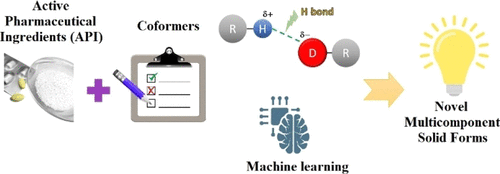当前位置:
X-MOL 学术
›
Cryst. Growth Des.
›
论文详情
Our official English website, www.x-mol.net, welcomes your
feedback! (Note: you will need to create a separate account there.)
Virtual Multicomponent Crystal Screening: Hydrogen Bonding Revisited
Crystal Growth & Design ( IF 3.2 ) Pub Date : 2021-09-15 , DOI: 10.1021/acs.cgd.1c00737 Soroush Ahmadi 1 , Pradip Kumar Mondal 1 , Yuanyi Wu 1 , Weizhong Gong 1 , Mahmoud Mirmehrabi 2 , Sohrab Rohani 1
Crystal Growth & Design ( IF 3.2 ) Pub Date : 2021-09-15 , DOI: 10.1021/acs.cgd.1c00737 Soroush Ahmadi 1 , Pradip Kumar Mondal 1 , Yuanyi Wu 1 , Weizhong Gong 1 , Mahmoud Mirmehrabi 2 , Sohrab Rohani 1
Affiliation

|
Pharmaceutical cocrystals, salts, and multicomponent crystals, in general, have increasingly come under the spotlight in recent years. A fast and efficient a priori theoretical classifier to identify potential coformers is highly sought after to complement the experimental brute force screening methods. This research examines the qualitative approaches that are based on hydrogen bonding strength. First, molecular electrostatic potential (MEP) maps of 330 coformers were obtained from density functional theory simulations, using two geometries: experimentally determined crystal structures and gas-phase optimization. An in-depth comparison of MEPs revealed the potential pitfalls of these two geometries that are deliberated at length in the manuscript. Next, six APIs and their reported salts/cocrystals on the Cambridge Structural Database (CSD) were inversely predicted with MEP analysis. For two of these APIs, the prediction showed systematic errors that are resolved with suggestions provided in the manuscript. Subsequently, hydrogen bond energy (HBE) and hydrogen bond propensity (HBP) calculations were put to the test with two APIs and 52 organic coformers. Finally, multivariate logistic regression, a linear machine learning (ML) algorithm, showed how a combination of HBE and HBP can be a superior classifier, for which 18 out of 25 positive cases were uninterruptedly identified at the top of the list. Provided that a database of failed attempts of cocrystallization is compiled within the scientific community to supplement the existing positive results (multicomponent crystals in the CSD), the combination of chemistry-based parameters and ML can be a promising classifier for coformer selection.
中文翻译:

虚拟多组分晶体筛选:重新审视氢键
近年来,药物共晶、盐和多组分晶体总体上越来越受到关注。一种快速有效的先验理论分类器来识别潜在的coformers 受到高度追捧,以补充实验蛮力筛选方法。本研究考察了基于氢键强度的定性方法。首先,330 个共形成体的分子静电势 (MEP) 图是从密度泛函理论模拟中获得的,使用两种几何形状:实验确定的晶体结构和气相优化。对 MEP 的深入比较揭示了手稿中详细讨论的这两种几何形状的潜在缺陷。下一个,剑桥结构数据库 (CSD) 上的六种 API 及其报告的盐/共晶用 MEP 分析进行了反向预测。对于其中两个 API,预测显示了系统错误,这些错误已通过手稿中提供的建议解决。随后,使用两种 API 和 52 种有机共形成剂对氢键能 (HBE) 和氢键倾向 (HBP) 计算进行了测试。最后,多元逻辑回归,一种线性机器学习 (ML) 算法,展示了 HBE 和 HBP 的组合如何成为优秀的分类器,其中 25 个阳性案例中有 18 个被不间断地识别在列表的顶部。如果在科学界内编译了一个共结晶失败尝试的数据库,以补充现有的积极结果(CSD 中的多组分晶体),
更新日期:2021-10-06
中文翻译:

虚拟多组分晶体筛选:重新审视氢键
近年来,药物共晶、盐和多组分晶体总体上越来越受到关注。一种快速有效的先验理论分类器来识别潜在的coformers 受到高度追捧,以补充实验蛮力筛选方法。本研究考察了基于氢键强度的定性方法。首先,330 个共形成体的分子静电势 (MEP) 图是从密度泛函理论模拟中获得的,使用两种几何形状:实验确定的晶体结构和气相优化。对 MEP 的深入比较揭示了手稿中详细讨论的这两种几何形状的潜在缺陷。下一个,剑桥结构数据库 (CSD) 上的六种 API 及其报告的盐/共晶用 MEP 分析进行了反向预测。对于其中两个 API,预测显示了系统错误,这些错误已通过手稿中提供的建议解决。随后,使用两种 API 和 52 种有机共形成剂对氢键能 (HBE) 和氢键倾向 (HBP) 计算进行了测试。最后,多元逻辑回归,一种线性机器学习 (ML) 算法,展示了 HBE 和 HBP 的组合如何成为优秀的分类器,其中 25 个阳性案例中有 18 个被不间断地识别在列表的顶部。如果在科学界内编译了一个共结晶失败尝试的数据库,以补充现有的积极结果(CSD 中的多组分晶体),











































 京公网安备 11010802027423号
京公网安备 11010802027423号